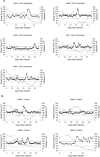Lymphocyte proliferation responses induced to broadly reactive Th peptides did not protect against equine infectious anemia virus challenge
- PMID: 16085917
- PMCID: PMC1182189
- DOI: 10.1128/CDLI.12.8.983-993.2005
Lymphocyte proliferation responses induced to broadly reactive Th peptides did not protect against equine infectious anemia virus challenge
Abstract
The effect of immunization with five lipopeptides, three containing T-helper (Th) epitopes and two with both Th and cytotoxic T-lymphocyte (CTL) epitopes, on equine infectious anemia virus (EIAV) challenge was evaluated. Peripheral blood mononuclear cells from EIAV lipopeptide-immunized horses had significant proliferative responses to Th peptides compared with those preimmunization, and the responses were attributed to significant responses to peptides Gag from positions 221 to 245 (Gag 221-245), Gag 250-269, and Pol 326-347; however, there were no consistent CTL responses. The significant proliferative responses in the EIAV lipopeptide-immunized horses allowed testing of the hypothesis that Th responses to immunization would enhance Th and CTL responses following EIAV challenge and lessen the viral load and the severity of clinical disease. The EIAV lipopeptide-immunized group did have a significant increase in proliferative responses to Th peptides 1 week after virus challenge, whereas the control group did not. Two weeks after challenge, a significant CTL response to virus-infected cell targets occurred in the EIAV lipopeptide-immunized group compared to that in the control group. These Th and CTL responses did not significantly alter either the number of viral RNA copies/ml or disease severity. Thus, lipopeptide-induced proliferative responses and enhanced Th and CTL responses early after virus challenge were unable to control challenge virus load and clinical disease.
Figures


Similar articles
-
Gag protein epitopes recognized by CD4(+) T-helper lymphocytes from equine infectious anemia virus-infected carrier horses.J Virol. 1999 May;73(5):4257-65. doi: 10.1128/JVI.73.5.4257-4265.1999. J Virol. 1999. PMID: 10196322 Free PMC article.
-
Cytotoxic T lymphocytes in protection against equine infectious anemia virus.Anim Health Res Rev. 2004 Dec;5(2):271-6. doi: 10.1079/ahr200482. Anim Health Res Rev. 2004. PMID: 15984338 Review.
-
Envelope-specific T-helper and cytotoxic T-lymphocyte responses associated with protective immunity to equine infectious anemia virus.J Gen Virol. 2007 Apr;88(Pt 4):1324-1336. doi: 10.1099/vir.0.82391-0. J Gen Virol. 2007. PMID: 17374779
-
Gag protein epitopes recognized by ELA-A-restricted cytotoxic T lymphocytes from horses with long-term equine infectious anemia virus infection.J Virol. 1998 Dec;72(12):9612-20. doi: 10.1128/JVI.72.12.9612-9620.1998. J Virol. 1998. PMID: 9811694 Free PMC article.
-
[Study on the role of cytotoxic T lymphocytes during equine infectious anemia virus infection and its epitope specificity].Bing Du Xue Bao. 2007 Jan;23(1):76-8. Bing Du Xue Bao. 2007. PMID: 17886727 Review. Chinese. No abstract available.
Cited by
-
Envelope determinants of equine infectious anemia virus vaccine protection and the effects of sequence variation on immune recognition.J Virol. 2008 Apr;82(8):4052-63. doi: 10.1128/JVI.02028-07. Epub 2008 Jan 30. J Virol. 2008. PMID: 18234792 Free PMC article.
-
Bovine immune response to inoculation with Neospora caninum surface antigen SRS2 lipopeptides mimics immune response to infection with live parasites.Clin Vaccine Immunol. 2008 Apr;15(4):659-67. doi: 10.1128/CVI.00436-07. Epub 2008 Feb 27. Clin Vaccine Immunol. 2008. PMID: 18305105 Free PMC article.
-
Targeting TLR2 for vaccine development.J Immunol Res. 2014;2014:619410. doi: 10.1155/2014/619410. Epub 2014 Jun 26. J Immunol Res. 2014. PMID: 25057505 Free PMC article. Review.
-
A pilot study comparing the development of EIAV Env-specific antibodies induced by DNA/recombinant vaccinia-vectored vaccines and an attenuated Chinese EIAV vaccine.Viral Immunol. 2012 Dec;25(6):477-84. doi: 10.1089/vim.2012.0014. Epub 2012 Nov 21. Viral Immunol. 2012. PMID: 23171359 Free PMC article.
-
Viral load and clinical disease enhancement associated with a lentivirus cytotoxic T lymphocyte vaccine regimen.Vaccine. 2009 Apr 21;27(18):2453-68. doi: 10.1016/j.vaccine.2009.02.048. Epub 2009 Feb 24. Vaccine. 2009. PMID: 19368787 Free PMC article.
References
-
- Albright-Fraser, D. G., R Reid, V. Gerber, and E. Bailey. 1996. Polymorphism of DRA among equids. Immunogenetics 43:315-317. (Erratum, 44:487.) - PubMed
-
- BenMohamed, L., H. Gras-Masse, A. Tartar, P. Daubersies, K. Brahimi, M. Bossus, A. Thomas, and P. Druilhe. 1997. Lipopeptide immunization without adjuvant induces potent and long-lasting B, T helper, and cytotoxic T lymphocyte responses against a malaria liver stage antigen in mice and chimpanzees. Eur. J. Immunol. 27:1242-1253. - PubMed
-
- Bernoco, D., D. F. Antczak, E. Bailey, K. Bell, R. W. Bull, G. Byrns, G. Guerin, S. Lazary, J. McClure, J. Templeton, and H. Varewyck. 1987. Joint report of the fourth international workshop on lymphocyte alloantigens of the horse, Lexington, Kentucky, 12-22 October 1985. Anim. Genet. 18:81-94. - PubMed
-
- Betts, M. R., D. R. Ambrozak, D. C. Douek, S. Bonhoeffer, J. M. Brenchley, J. P., Casazza, R. A. Koup, and L. J. Picker. 2001. Analysis of total human immunodeficiency virus (HIV)-specific CD4+ and CD8+ T-cell responses: relationship to viral load in untreated HIV infection. J. Virol. 75:11983-11991. - PMC - PubMed
Publication types
MeSH terms
Substances
Grants and funding
LinkOut - more resources
Full Text Sources

